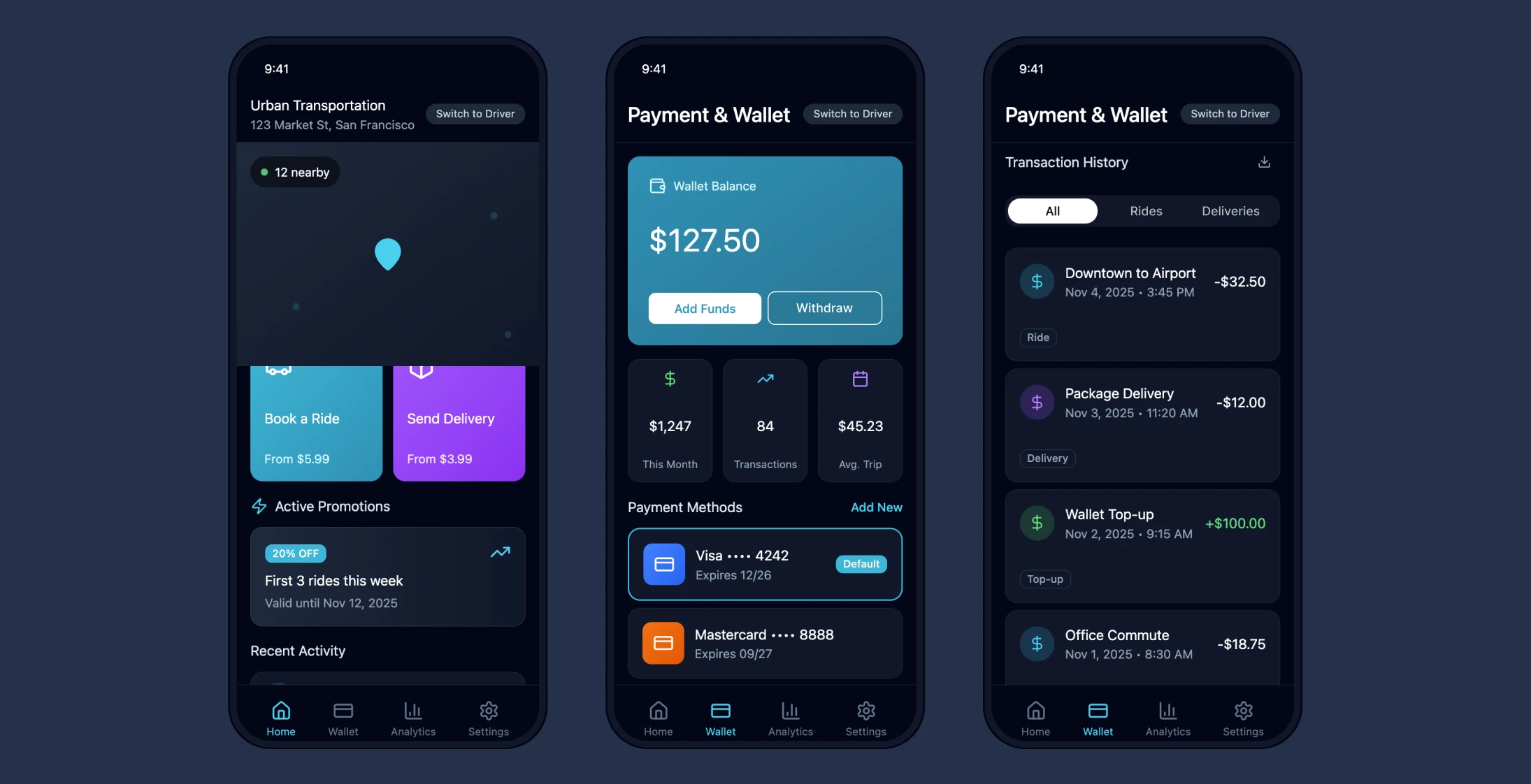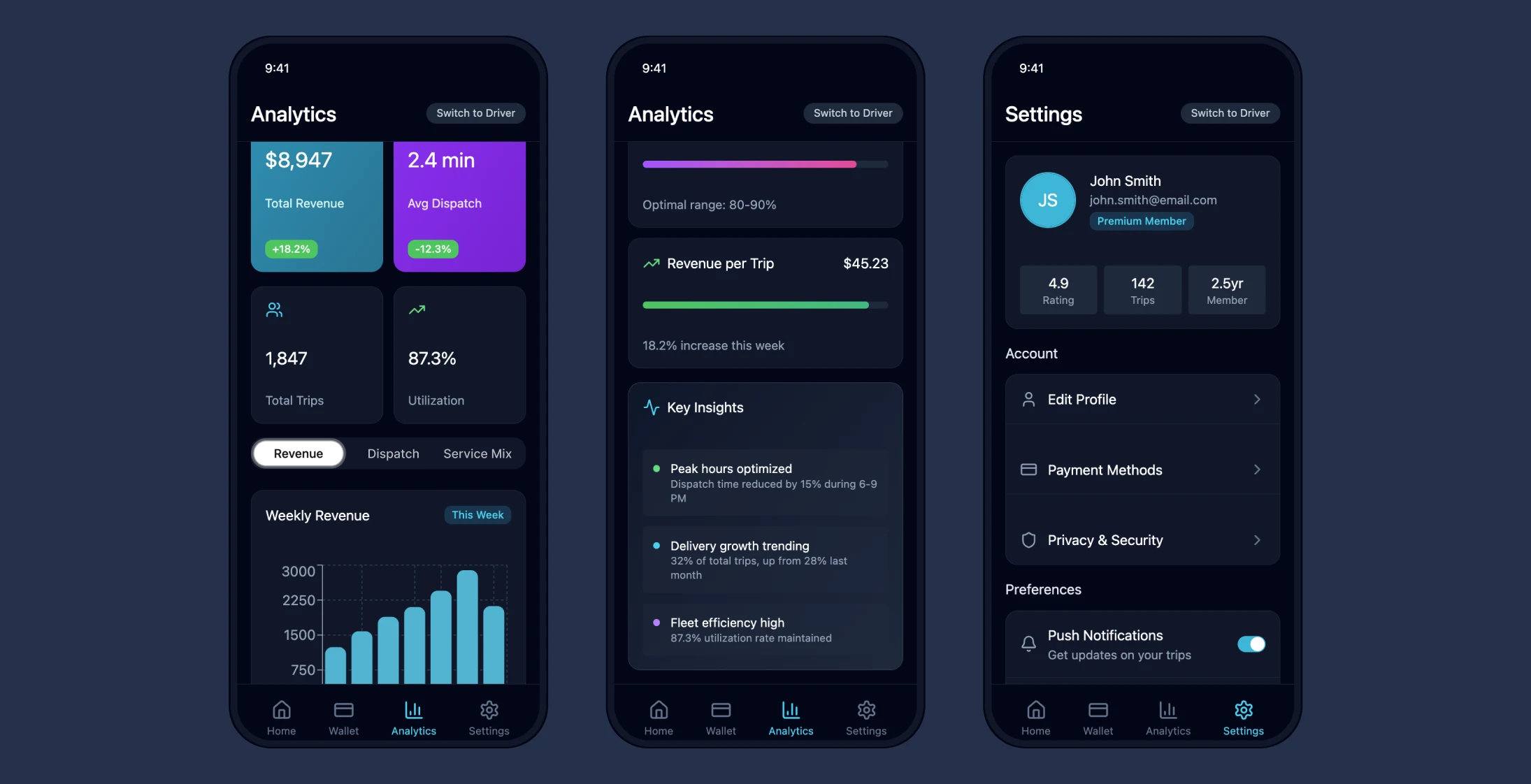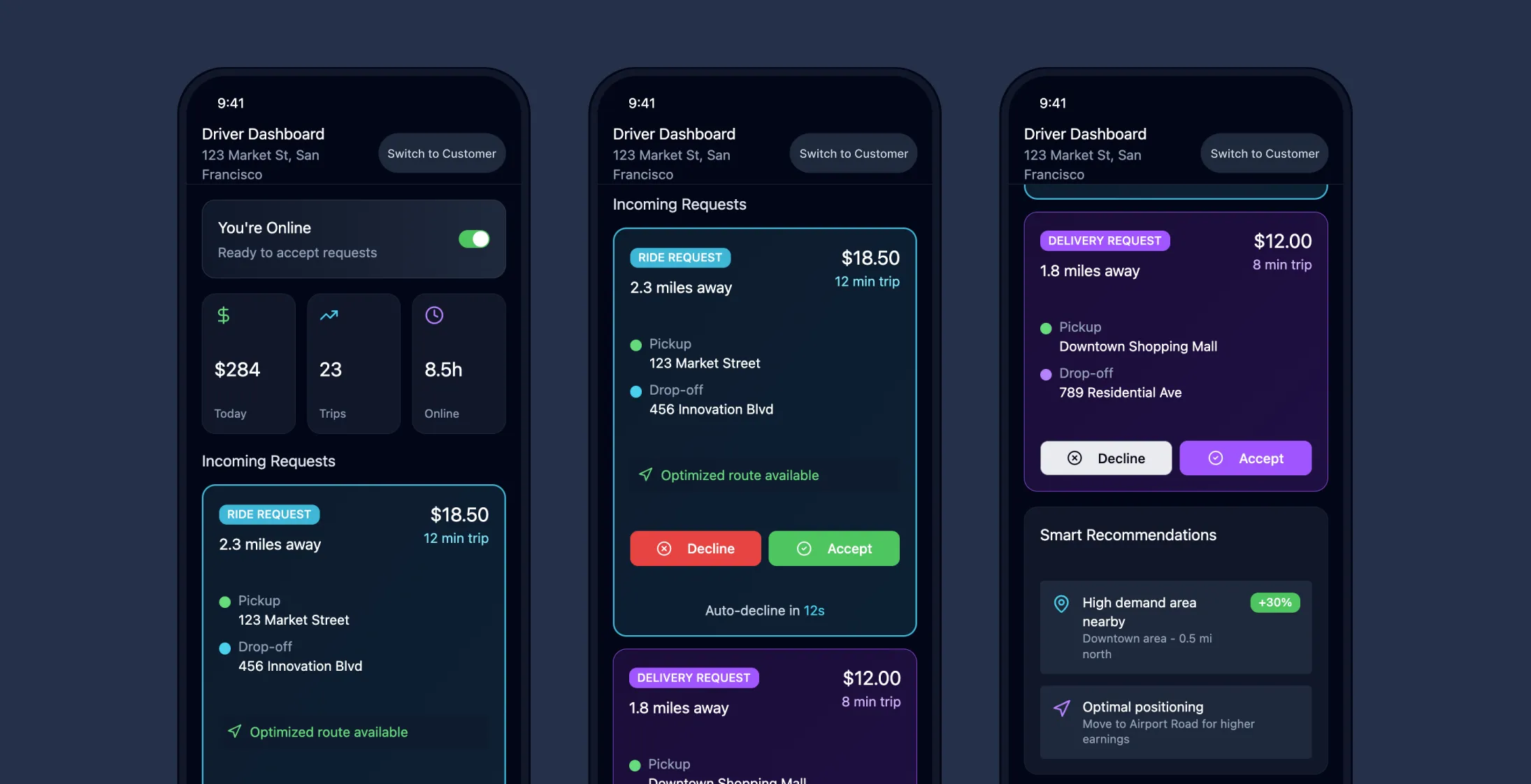


Project Overview
A unified mobile platform integrates transportation and on-demand delivery services into one system. This eliminates the requirement for using multiple applications.
Real-time matching algorithms designed for both modes of operation have led to an 89 percent reduction in dispatch times and a 34 percent increase in resource utilization for fleet operations.
The architecture that responds to events, combined with distributed state management, smoothly accommodated the growth to support 2,300,000 users per day while maintaining a 99.96 percent uptime rate.
Integrated payment processing and dynamic pricing led to a 67 percent decrease in transaction failures, boosting provider earnings with route planning and surge pricing strategies.
Market Challenges and Requirements
Urban transportation markets are now requiring transportation options that can adjust to user requirements throughout the day instead of relying solely on single-use platforms that cause inconvenience with switching between apps and managing multiple accounts. Meanwhile, operators face challenges in maximizing their fleet usage during non-busy times for their main services.
The integration of ride-sharing and delivery services poses hurdles concerning:
- Resource distribution and optimal routing
- Ensuring consistent operations across various modes of service provision
- Grouping and forecasting demand along with managing inventory in real-time
- Catering to both passenger and parcel delivery demands
Regulatory adherence differs across transportation and logistics sectors, necessitating structures that can adjust to various jurisdictions and service categories while upholding a consistent user experience and operational effectiveness.
User and Provider Pain Points
City dwellers encountered challenges with transportation apps scattered across platforms that demanded individual registration processes and payment mechanisms to navigate through them all smoothly or reliably access both ride-hailing and delivery services when necessary.
Service providers faced periods of downtime and lower earnings because of the fluctuation in demand when focusing solely on one type of service operation. The times when ride requests were at their highest rarely coincided with peak delivery demands, resulting in poor distribution of resources and lower satisfaction among drivers.
Technical Limitations of Legacy Systems
The current systems faced challenges in handling real-time matching tasks for multiple service categories at the same time. Older system structures were not equipped to manage the computational load required to optimize routes for both passenger and delivery requests while ensuring prompt response times.
The fragmentation in processing payments resulted in transaction failures and delayed settlements across service categories, leading to compliance issues for providers who required a unified system for tracking earnings and more adaptable payout choices than what conventional specialized platforms were able to provide effectively.
Legacy systems struggled with real-time optimization and unified payment processing, creating bottlenecks for both users and service providers.
Business Impact and Results
Cost Reduction and Revenue Growth
We managed to reduce user acquisition expenses by 45% with a unified platform strategy. This allowed us to eliminate the necessity for separate marketing budgets for both ride and delivery sectors.
The company enhanced driver earnings by 28% utilizing smart dispatch to minimize downtime between service types.
Enhanced customer loyalty was achieved by increasing the retention rate of users to 73% through mitigating obstacles in switching between apps and offering holistic mobile solutions within a unified platform.
We were able to cut operational costs by 31% thanks to streamlining operations with shared resources, improved customer service, and centralizing payment processing.
Compliance and Operational Efficiency
For compliance streamlining, we have made it easier to operate across jurisdictions by implementing a flexible service classification system that caters to various regulatory needs without the need for separate platforms.
Transform Your Transportation Business
Reduce costs by 31% and increase driver earnings by 28% with unified platform solutions.
System Architecture Overview
Microservices Framework
The system adopts a microservices framework with event-based communication styles that allow scalability of transportation and delivery functions while ensuring a consistent user experience is upheld.
Central services encompass:
- User administration and onboarding procedures for service providers
- Matching and optimal routing
- Payment handling and evaluation compilation
The distribution of segments spreads out the matching algorithms among regional clusters to decrease delays and enhance error resilience efficiently for each area's ongoing inquiries while also syncing with global services for inter-regional procedures and data analysis purposes.
Intelligent Matching System
The matching system uses a mix of algorithms that take into account:
- The type of service provided by the company and its capabilities
- Proximity and demand in specific areas
- Historical data patterns and current traffic situations
- Provider preferences and availability
Payment Processing Architecture
The payment structure allows for various types of transactions to be processed seamlessly by an integrated processor system and automatically directed based on the service category and regulatory standards in place. Split payments are managed to handle situations such as multi-stop deliveries and shared transportation services.
Core Service Components
User Management Service
User Management Service includes tasks such as:
- Authentication processes
- Managing user profiles and preferences
- Coordinating session management across services
Route Optimization Service
Route Optimization Service offers intelligent routing for deliveries and rides utilizing real-time traffic and optimal path calculations.
Payment Processing Service
The service for processing payments offers comprehensive provider transaction management with automated settlement and splitting of payments.
Request Processing Flow
The flow of requests is directed through the API gateway with limits on rates and validation of authentication credentials in place. Incoming requests that match criteria are placed into priority queues based on service category and geographical location. Furthermore, the system optimizes the handling of requests across queues to accommodate peak scenarios effectively.
Real-time location updates flow through messaging system infrastructure to keep track of service availability on nodes connected across the network of routes and destinations. Calculations for determining routes combine real-time traffic information from external APIs with analysis of historical patterns to make reliable predictions for estimated time of arrival (ETA).
Infrastructure and Deployment
Multi-Region Architecture
A setup with deployments across regions in an active-active configuration guarantees global accessibility and safeguards against disasters effectively. This deployment ensures optimal global availability and contingency plans in place for disaster recovery purposes to achieve global reach while operating efficiently at a local level.
Regional clusters oversee localized matching tasks while global services oversee user account management, payments, and cross-regional analytics.
Container Orchestration and Scaling
Container orchestration allows for adjustment of resources according to varying demand in different regions. It includes specific scaling strategies for computationally heavy matching algorithms and input/output intensive location tracking services.
Monitoring and Performance
Distributed Tracing and Analytics
Distributed tracing follows the flow of requests between service areas to pinpoint performance issues efficiently. Monitoring real-time metrics dashboards help keep an eye on:
- Success rates for matches made
- Speed of payment processing
- User experience signals
Automated alert systems pick up on any irregularities in demand patterns, provider availability, and system performance indicators.
Development and Testing Strategy
Iterative Development Process
The platform underwent a process of iterative development incorporating continuous integration to facilitate the seamless deployment of services. The use of feature flags allowed for gradual introduction of enhancements to the matching algorithm and new service categories without necessitating complete system updates.
Comprehensive Testing Framework
A thorough testing plan encompassed:
- Unit tests for business logic validation
- Integration tests for service interaction checks
- Performance testing during peak demand periods
- Load testing to gauge system resilience under high stress situations
- Chaos engineering principles to verify fault tolerance and recovery protocols
Implementing chaos engineering principles early in development helps identify potential failure points and improves system resilience.
Infrastructure Management
Infrastructure as Code
Maintaining consistency in infrastructure across development, staging, and production environments is achieved through the implementation of infrastructure as code practices. Staging setups simulate real data volumes to assess performance and conduct load testing prior to deploying to production.
Deployment Strategies
Blue-green deployment strategies reduced downtime when implementing updates by utilizing automated rollback triggers that respond to critical performance indicators and error rates.
The automated construction and deployment pipelines supported individual service launches that underwent dependency verification checks while incorporating security scans during the build phase to identify vulnerabilities prior to deploying to production systems.
Data Management and Migration
Database Migration Procedures
The migration procedures for databases allowed for seamless schema updates without any downtime using gradual modifications and feature toggles to enable new functions progressively.
System Migration Strategy
The gradual implementation initially focused on providing delivery services in select regions to establish protocols and monitoring functions effectively before extending to include ride-sharing services by leveraging existing infrastructure and operational expertise.
During the transition from legacy systems to new ones, data migration processes involved using dual-write methods to maintain data consistency and allow for rollbacks when deploying the new systems initially.
Security and Risk Management
System Protection Measures
The circuit breaker patterns helped safeguard services from cascading failures while regional failover features ensured service continuity in the event of infrastructure failures. Rate limiting and DDoS protection measures were put in place to safeguard APIs from abuse and sudden surges in traffic levels.
Financial Risk Management
The system for managing financial risks comprised limits on transactions along with algorithms for detecting fraud and automated monitoring of settlements to avoid processing errors in payments.
Performance Metrics and Results
Key Performance Indicators
The integrated platform showed significant enhancements in efficiency and user satisfaction metrics while also meeting industry standards for real-time matching performance and availability during peak demand times.
The enhancements in resource utilization for service providers led to higher profits and lower customer turnover rates, while ensuring reliable payment processing resolved a major issue causing user frustration and provider dissatisfaction within the previous system setup.
System Performance Metrics
| Metric | Previous Value | Current Value | Improvement |
|---|---|---|---|
| Payment Failure Rate | 3.7% | 1.2% | 67% reduction |
| API Response Time (P99) | >800ms | 387ms | 52% improvement |
| System Availability | 99.2% | 99.96% | 0.76% improvement |
| User Acquisition Cost | Baseline | Reduced | 45% reduction |
| Driver Earnings | Baseline | Increased | 28% increase |
| User Retention Rate | 45% | 73% | 62% improvement |
Lessons Learned and Best Practices
State Management Complexity
Initially dealing with the complexity of state management led to bottlenecks in high-concurrency situations. By incorporating event sourcing techniques along with optimistic locking, we were able to address consistency concerns without compromising performance. Moving forward, it is important for upcoming implementations to give precedence to eventual consistency models from the start of the architectural planning process.
Geographic Distribution Strategy
Creating a geographic division plan involves finding the optimal mix of local efficiency and global resource usage balance. Having the ability to match across regions is crucial during peak demand periods but can lead to latency in specific scenarios. Granting regional independence while setting up cross-region coordination offers the best level of flexibility available for this strategy.
Payment System Integration
Integrating payment processing across service types has led to complexities involving refunds, partial payments, and split transactions. Investments made in sophisticated transaction state machines and reconciliation procedures help avoid operational disruptions and mitigate customer dissatisfaction.
Machine Learning Model Deployment
Implementing machine learning models for matching optimization necessitated a robust approach to A/B testing infrastructure to avoid compromising user experience when updating algorithms. Being able to introduce changes gradually while monitoring performance in real-time facilitates a secure iteration process of ML models in production environments.
Provider Capacity Management
Incorporating provider capacity monitoring at an early stage of development allows for smooth service growth. Design adaptability for provider recruitment and capacity validation facilitates market entry for new service categories without needing major structural modifications.
Data Synchronization Challenges
During network outages, the real-time syncing of data between nodes sometimes caused discrepancies in information flow. By incorporating conflict resolution tactics and backup plans for system performance, we can uphold service accessibility and safeguard data accuracy even amidst infrastructure disruptions.
Payment system complexity increases significantly when handling multiple service types. Plan for comprehensive transaction state management from the beginning.
Technology Stack Components
Core Infrastructure
- Message Queue System: Enables asynchronous task processing and supports event-driven architecture
- Machine Learning Platform: Used for demand forecasting, matching optimization, and fraud detection
- Container Orchestration: Manages scalable deployment across multiple regions
- API Gateway: Handles request routing, rate limiting, and authentication
The unified platform approach has proven successful in addressing the complex challenges of modern urban transportation while delivering significant business value and improved user experiences across both transportation and delivery services.
Project Results
- 89% reduction in dispatch times
- 34% increase in resource utilization
- 67% decrease in transaction failures
- 99.96% system uptime achieved
- 2.3M daily users supported
- 45% reduction in user acquisition costs
- 28% increase in driver earnings
- 73% user retention rate
Key Performance Metrics
Dispatch Reduction
Reduction in dispatch times
Resource Utilization
Increase in fleet efficiency
System Uptime
Platform availability
Daily Users
Supported concurrent users


